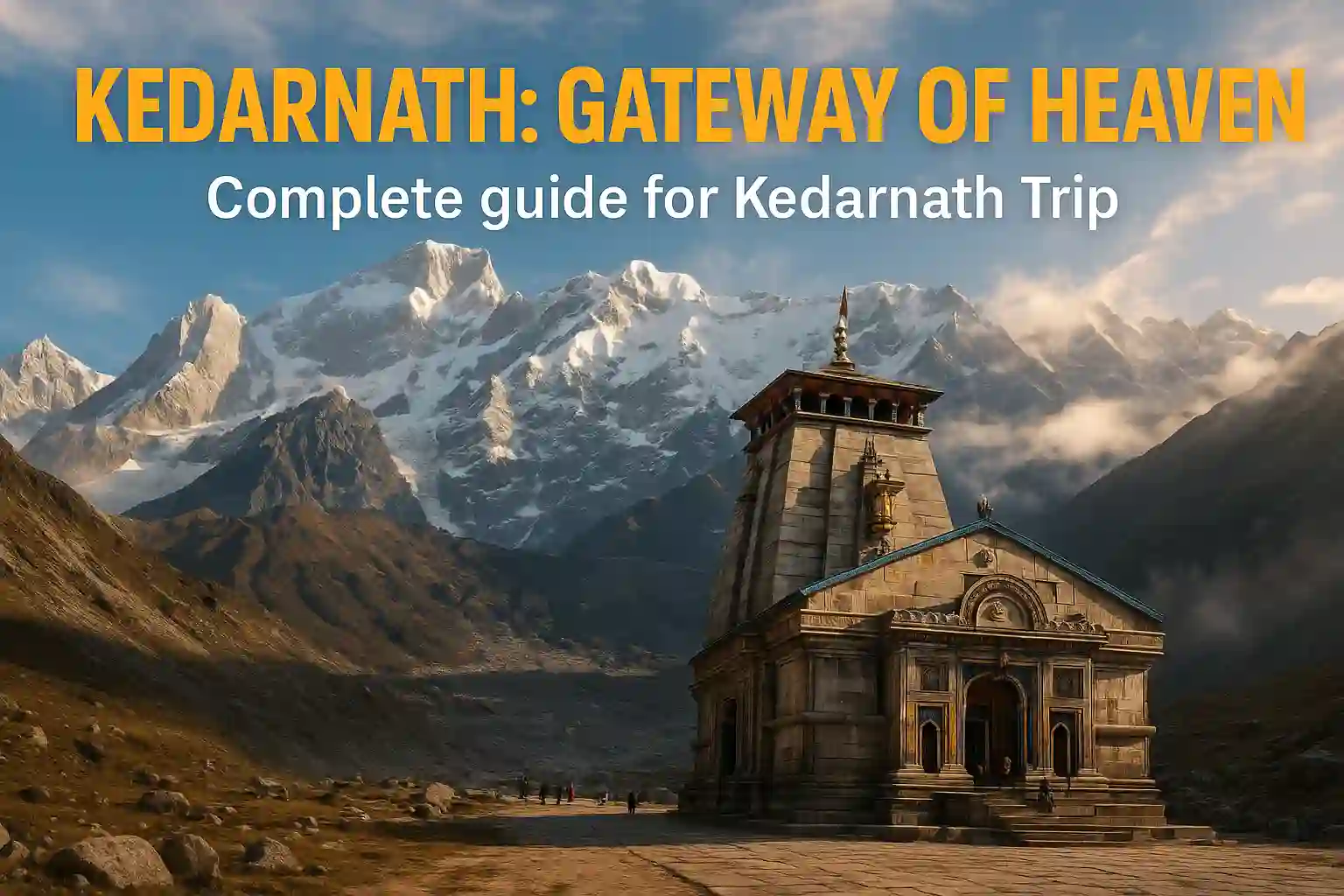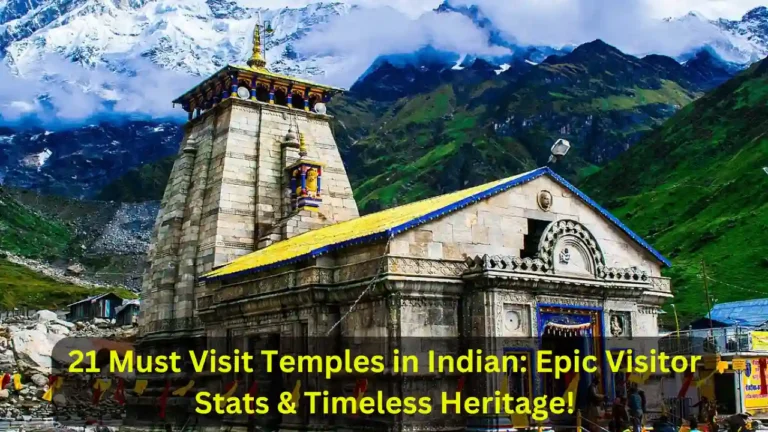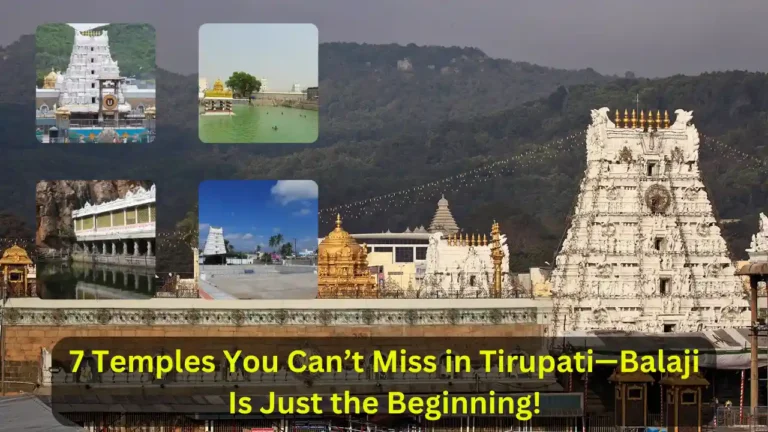Kedarnath Temple: Your Complete 2025 Guide to Visiting the Sacred Himalayan Shrine
Did you know that in 2023 alone, a staggering 19.6 lakh (1.96 million) pilgrims answered the call of Kedarnath?
That’s almost two million souls drawn to this powerful Himalayan shrine, surpassing even the revered Badrinath Temple in footfall for the first time in recent history.
With numbers soaring year after year (up from 15.6 lakh in 2022), the spiritual magnetism of Kedarnath is undeniable. Are you feeling the pull? Are you wondering if 2025 is your year to experience its magic?
If the thought of planning this epic journey brings a whirlwind of questions – When should I go? How do I even get there? What will it cost? Is the trek too hard?
What about accommodation? – take a deep breath. You’re not alone. Planning a trip to such a significant and remote location can feel overwhelming. But don’t worry.
This guide is designed to be your trusted companion, answering every question clearly and comprehensively.
We’ll break down everything you need for a successful and spiritually enriching pilgrimage to Lord Shiva’s Himalayan abode.

Why is Kedarnath Temple So Famous and Important?
Kedarnath’s immense significance stems from multiple layers of religious and cultural importance:
One of the 12 Jyotirlingas
It’s revered as one of the holiest Hindu shrines dedicated to Lord Shiva, housing one of the twelve naturally occurring Jyotirlingas (manifestations of Shiva).
Panch Kedar
It’s the highest among the five sacred Shiva temples known as the Panch Kedar, believed to have been built by the Pandavas after the Mahabharata war seeking forgiveness from Lord Shiva.
Mahabharata Connection
Legend holds that the Pandavas sought Lord Shiva here, who eluded them by taking the form of a bull. Bhima tried to catch him, but the bull dived into the ground, leaving his hump behind at Kedarnath. Other parts of the bull are worshipped at the other Panch Kedar temples.
Breathtaking Location
The sheer beauty and raw power of its Himalayan setting at approx. 3,583 meters contribute significantly to its mystical allure. The challenging journey itself is often considered an integral part of the spiritual experience.
Adi Shankaracharya
The great philosopher and saint Adi Shankaracharya is believed to have attained Mahasamadhi (final conscious exit from the body) near Kedarnath Temple in the 8th century CE, further sanctifying the site.
When is the Best Time to Visit Kedarnath (2025)?
Kedarnath Temple is not open year-round due to extreme weather conditions. Choosing the right window is crucial for a safe and pleasant journey.
| Month(s) | Typical Status | Weather Conditions | Crowd Level | Recommendation |
| Late Apr/May | Opens | Pleasant days, very cold nights. Snow melt possible. | Very High | Good: Start of season, book well in advance. |
| June | Open | Generally pleasant days, cold nights. | Very High | Good: Peak season, expect maximum crowds. |
| July – August | Open | Monsoon Season: Heavy rain, landslide risk. | Moderate | Not Recommended: High travel risks, heli disruptions. |
| September | Open | Post-monsoon clarity, crisp air, cool days/nights. | High | Excellent: Clear views, comfortable trekking. |
| October | Open | Clear skies, getting colder, possible early snow. | High | Good: Beautiful but pack for increasing cold. |
| Nov – Early Apr | Closes | Extreme cold, heavy snowfall, inaccessible. | Closed | Temple closed for winter. |
- 2025 Opening Date (Expected): Around Akshaya Tritiya (Late April/Early May). Official date announced closer to the time.
- 2025 Closing Date (Expected): Around Bhai Dooj (Late October/Early November). Official date announced closer to the time.
How to Reach Kedarnath Temple: Transportation Breakdown
Reaching Kedarnath involves multiple stages. Here’s a summary of options:
Stage 1 & 2: Reaching Gaurikund (Trek Base)
- Nearest Airport: Jolly Grant Airport, Dehradun (DED) – Approx. 238 km to Sonprayag.
- Nearest Railway Stations: Rishikesh (RKSH) & Haridwar (HW).
- Road Travel: Buses/Taxis available from Delhi/Haridwar/Rishikesh/Dehradun to Sonprayag.
- Sonprayag to Gaurikund (5 km): Mandatory local shuttle taxis.
Stage 3: Gaurikund to Kedarnath Temple (Approx. 16-18 km)
| Mode | Approx. Time | Difficulty / Effort | Approx. Cost (One Way – 2024 Rates) | Key Considerations |
| Trekking | 6-8 Hours | Moderate to Challenging | Free | Requires good fitness, acclimatization. Offers scenic views. Start early. |
| Helicopter | 7-10 Minutes | Minimal Physical Effort | ₹2,500 – ₹4,000+ (Varies Highly) | Book only via official UCADA portal. Weather dependent. Limited baggage. Fast. |
| Pony/Mule | 4-6 Hours | Low Physical Effort (Rider) | ₹2,500 – ₹3,500+ | Available at Gaurikund. Rates usually fixed. Ensure humane treatment. |
| Palki/Dandi | 7-9 Hours | Minimal Physical Effort | ₹5,000 – ₹10,000+ | Carried by porters. Most expensive option. Available at Gaurikund. |
Accommodation Options near Kedarnath
- Near the Temple (Limited & Basic): GMVN cottages/tents, private lodges, ashrams. Booking GMVN far in advance is essential. Facilities are basic due to altitude and remoteness. Expect shared facilities in many places.
- En Route: Basic camps (e.g., Linchauli) managed by GMVN during peak season.
- Gaurikund/Sonprayag: Wider range of budget hotels and guesthouses. Suitable for staying before/after the trek.
Estimated Budget for Kedarnath Trip (Per Person – 2025 Estimate)
This budget varies greatly. Use this as a general guideline (based on 3-4 days ex-Haridwar/Rishikesh):
| Expense Category | Budget Trekker (₹) | Mid-Range (₹) | Helicopter Traveler (₹) | Notes |
| Transport (to Sonprayag & back) | 2,000 – 3,500 | 3,000 – 5,000 | 3,000 – 6,000 | Bus/Shared Taxi vs Private Taxi |
| Local Transport (Sonprayag-Gauri) | 100 – 200 | 100 – 200 | 100 – 200 | Fixed rate shared taxis |
| Accommodation | 1,500 – 3,000 | 3,000 – 5,000 | 3,000 – 6,000 | Basic shared vs Private room/GMVN |
| Food | 1,500 – 2,500 | 2,000 – 3,500 | 2,000 – 4,000 | Basic meals vs Restaurant options |
| Gaurikund to Kedarnath | 0 (Trek) | 5,000 – 7,000 (Pony) | 5,000 – 8,000+ (Heli) | One round trip cost estimate |
| Miscellaneous | 1,000 – 1,500 | 1,500 – 2,500 | 2,000 – 3,000 | Permits, registration, small purchases |
| Estimated Total (Approx.) | ₹6,100 – ₹10,700 | ₹14,600 – ₹23,200 | ₹15,100 – ₹27,200+ | Highly variable, verify current rates |
Important Tips for Your Kedarnath Pilgrimage (2025)
- Mandatory Registration: Register online via the official Uttarakhand Tourism portal before your trip. This is crucial for managing pilgrim flow and safety. Check the latest registration process.
- Acclimatize: Spend at least one night at a lower altitude (Guptkashi/Sonprayag) before ascending to Kedarnath to prevent AMS.
- Medical Fitness: Consult your doctor, especially if elderly or with health conditions. Carry prescribed medications. Basic medical facilities are available, but limited.
- Pack Smart: Warm layers (thermals, fleece, windproof/waterproof jacket), sturdy trekking shoes, woolen cap, gloves, sunscreen, sunglasses, first-aid kit, torch, power bank, reusable water bottle.
- Stay Hydrated & Energized: Drink plenty of water. Carry snacks like nuts, dried fruits, energy bars. Avoid alcohol and caffeine.
- Book in Advance: Accommodation (especially GMVN) and helicopter tickets (if using) need booking months ahead, particularly for May-June & Sept-Oct.
- Carry Cash: Network connectivity is poor. ATMs are scarce beyond main towns. Carry sufficient cash.
- Travel Insurance: Strongly recommended for medical emergencies and cancellations.
- Respect & Responsibility: Dress modestly, respect customs, don’t litter, protect the fragile environment.
- Check Weather & Road Conditions: Stay updated via official channels. Be prepared for sudden changes.
- Start Early: Begin your trek or helicopter journey early to maximize daylight and avoid afternoon weather changes.
Darshan and Temple Rituals
The inner sanctum (Garbhagriha) houses the conical rock formation worshipped as the Jyotirlinga. General darshan involves viewing this sacred form. Expect queues, especially during peak hours. Temple timings vary slightly but generally open early morning, close for a period in the afternoon, and reopen until evening. Special pujas can be pre-booked (check official BKTC website). Photography inside the inner sanctum is strictly prohibited.
Conclusion: A Journey of Faith, Endurance, and Awe
A pilgrimage to Kedarnath is undeniably challenging, demanding physical endurance and mental fortitude.
Yet, the reward is immeasurable – a deep sense of spiritual connection, the humbling experience of faith amidst millions, and the unforgettable vista of Lord Shiva’s majestic Himalayan abode.
In 2023, over 1.96 million pilgrims made this journey, a testament to its enduring power. With careful planning using this guide, your 2025 visit can be safe, respectful, and profoundly transformative. Prepare well, travel responsibly, and embrace the divine energy of Kedarnath.






